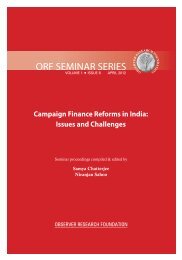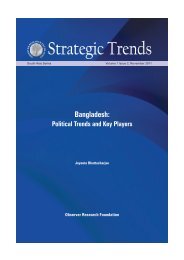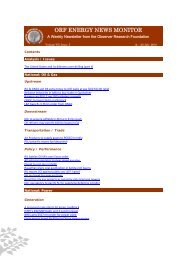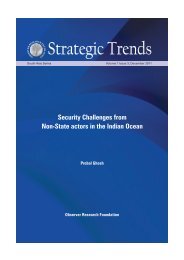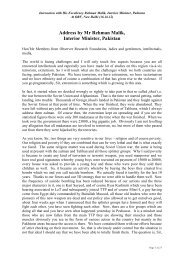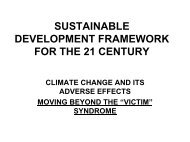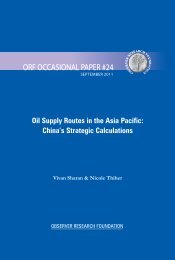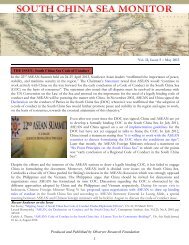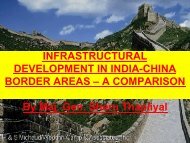Oil Supply Routes in the Asia Pacific: China's Strategic Calculations
Oil Supply Routes in the Asia Pacific: China's Strategic Calculations
Oil Supply Routes in the Asia Pacific: China's Strategic Calculations
Create successful ePaper yourself
Turn your PDF publications into a flip-book with our unique Google optimized e-Paper software.
<strong>Oil</strong> <strong>Supply</strong> <strong>Routes</strong> <strong>in</strong> <strong>the</strong> <strong>Asia</strong> <strong>Pacific</strong>: Ch<strong>in</strong>a’s <strong>Strategic</strong> <strong>Calculations</strong><br />
respectively hav<strong>in</strong>g up <strong>the</strong> largest proportions (Qatar comes <strong>in</strong> a distant<br />
th<br />
6 —none<strong>the</strong>less it is strategically important because it is likely to be a major<br />
supplier of natural gas to Ch<strong>in</strong>a <strong>in</strong> <strong>the</strong> future). Consequently, <strong>the</strong>se are <strong>the</strong><br />
countries that are of long term importance to Ch<strong>in</strong>a <strong>in</strong> terms of its energy<br />
supply needs. Ch<strong>in</strong>a’s oil imports from <strong>the</strong>se major players have grown<br />
rapidly <strong>in</strong> <strong>the</strong> last two decades. It can be argued that supply arrangements<br />
with o<strong>the</strong>r countries <strong>in</strong> <strong>the</strong> region are likely to be short term engagements.<br />
Figure 3<br />
Percentage of Global <strong>Oil</strong> Reserves <strong>in</strong> <strong>the</strong><br />
Middle East <strong>in</strong> 2010<br />
United Arab<br />
Emirates,<br />
7.1%<br />
Iran, 9.9%<br />
Iraq, 8.3%<br />
Saudi Arabia,<br />
19.1%<br />
Qatar, 1.9%<br />
Kuwait, 7.3%<br />
Source: BP Statistical Review of World Energy 2011<br />
In 1999, Ch<strong>in</strong>ese President Jiang Zem<strong>in</strong> visited Saudi Arabia on a state visit<br />
and pronounced a “strategic oil partnership” between <strong>the</strong> two countries. In<br />
November 2010, Ch<strong>in</strong>a overtook <strong>the</strong> US as Saudi Arabia's biggest oil<br />
customer. It buys more than a million bpd from Saudi Arabia—constitut<strong>in</strong>g<br />
approximately a fifth of its total imports. Ch<strong>in</strong>a's total imports have doubled<br />
s<strong>in</strong>ce 2005; an <strong>in</strong>dication of <strong>the</strong> fast pace at which Ch<strong>in</strong>ese demand and<br />
bilateral ties are grow<strong>in</strong>g <strong>in</strong> what is today perhaps <strong>the</strong> world's most<br />
significant energy relationship. The relationship is enhanced by <strong>the</strong> fact that<br />
Ch<strong>in</strong>a has been grant<strong>in</strong>g many downstream projects to Saudi Aramco and<br />
Saudi Basic Industries Company <strong>in</strong> Ch<strong>in</strong>a, and <strong>the</strong>re are about 90 Ch<strong>in</strong>ese<br />
www.orfonl<strong>in</strong>e.org 7



